Artificial Intelligence (AI) has become an increasingly important tool for project management in recent years. As the technology continues to develop, AI tools for project management are becoming increasingly sophisticated and capable of helping teams efficiently manage projects of all sizes and types.
This article will explore the best AI tools for project management, including an in-depth look at the features, benefits, and factors to consider when selecting the right software for your team’s needs. The article will provide an overview of the top providers and their pricing, features, customer support, ease of use, and other category-specific attributes.
Additionally, tips for selecting the best AI tool for project management will be provided.
Key Takeaways
- The article discusses the top 10 project management software options 2023, rated based on factors such as pricing, features, customer support, and ease of use.
- It also provides information on the categories of project management software, benefits of using such software, tips for choosing one, and specific features of the top options, such as ClickUp’s Agile Scrum features, monday.com’s free version for small teams, and Asana’s multitude of collaboration tools.
- When choosing a project management software, it is important to consider factors such as cost, overall features and functionality offerings, reporting, integration capabilities, necessary features vs. feature overload, customer reviews, and customer support.
- Some essential project management software features include budget planning tools, resource management tools, task management features, risk management features, reports and charts, mobile apps, and integrations.
What Is Project Management Software?
Project management software is designed to support the successful execution of projects by providing streamlined and collaborative planning, task allocation, team organization, and goal-tracking tools.
The software typically involves the use of a web-based platform that serves as a central hub for tasks, document sharing, and project communication.
It tracks project progress, assigns roles, and monitors deadlines and other project tasks. The software can be tailored to the needs of any individual project, as well as to the specific requirements of any organization.
It is useful for a wide range of applications, from small teams to large enterprises. Project management software features include task lists, calendars, project boards, timelines, resource management, budgeting tools, and integration capabilities.
They also provide tools to manage risks, ensure quality control, and track project progress. The software can be used to assign tasks to team members, monitor progress, and track costs.
It can also be used to create reports and dashboards to track progress and identify areas that need attention.
How To Choose the Best Project Management Software
Selecting the optimal project management software for any organization requires careful consideration of a number of factors. Cost and added fees, overall features and functionality offerings, reporting, integration capabilities, necessary features vs. feature overload, customer reviews and customer support should be considered.
Essential project management software features include budget planning tools, resource management tools, task management features, risk management features, reports and charts, a mobile app, integrations, client management tools, collaboration tools, demos and team feedback.
Budget planning tools allow users to upload a set budget and track expenses, while resource management tools help to identify gaps in availability and adjust resource allocation. Task management features include automations, boards, calendars, timeline views, scheduling, task tracking and task prioritization. Risk management features help to balance competing demands to finish the project as intended, while reports and charts provide an overview of the timeline.
Mobile apps help teams track, manage and deliver project deliverables from anywhere. Integrations help to boost performance and cater the software to specific needs, while client management tools help to include clients in the project’s execution. Collaboration tools, demos and team feedback are also important considerations.
Essential Project Management Software Features
When selecting project management software, ease of use is an essential consideration.
Beyond features, consider the reporting and analytics capabilities of the software, as well as customer reviews and customer support.
Additionally, consider business size considerations as some software may be better suited for larger or smaller companies.
Ease of Use
When assessing project management software, ease of use should be a major consideration for organizations to ensure the software can be used efficiently and effectively.
Various features can make the software easier to use and more suitable for an organization’s needs. Such features include templates, which incorporate project management best practices, and learning materials such as knowledge bases and demos to help project managers and team members understand how to use the software.
Automation can also simplify complex tasks by taking them out of the hands of people, making the software’s involvement in project management easier to manage.
Additionally, project management software should offer client management tools that allow teams to include clients in the project’s execution, keep them up to date on the project’s status, and maintain a professional relationship.
Finally, collaboration tools should be available to help project execution team members work together seamlessly, even across locations. With these features in place, organizations can use project management software more efficiently and effectively.
Reporting and Analytics
Analyzing data and creating reports are essential components of project management software that enable teams to track progress and make informed decisions.
Project management software offers a variety of reporting and analytics features to meet the needs of teams. These features include generating comprehensive reports, analysing data, identifying trends and anomalies, tracking performance, and visualising data in charts and graphs. Reports can be tailored to the needs of an organization, with the ability to drill down into the data for more detailed analysis.
Most project management software also provides forecasting, budgeting, and resource allocation tools. These tools are essential for staying on top of a project’s progress and making informed decisions.
With the right project management software, teams have the power to turn data into actionable insights for improved performance.
Customer Reviews
Reading customer reviews can provide invaluable insight into the usability and effectiveness of project management software. Customer reviews can provide a comprehensive overview on how a project management software works, its features, customer support, and experiences with the software.
Some key benefits of customer reviews include:
- Ability to understand the software’s user experience from the perspective of those who have already used it
- An understanding of the customer support services and its helpfulness
- An understanding of the ease-of-use of the software
- An understanding of how well the software meets user expectations and needs.
Customer Support
Customer support is an important factor to consider when selecting a project management software. It is important to determine the quality and availability of customer support when evaluating a project management software.
Look for customer support options such as phone, email, webchat, and forums. These options should be available 24/7.
Read customer reviews to gain insight into the customer service provided by the company. Additionally, consider the response time and quality of customer support, as this could impact the project’s success.
It is also important to determine the level of expertise provided by customer support staff and if there are additional fees associated with customer support. Research customer support policies and procedures to gain further insight into the expected customer service.
Business Size Considerations
When selecting project management software, it is important to consider the size of the business and how it affects the software’s features and functionality. Small businesses may need fewer features, while larger businesses may require more features. Additionally, larger businesses may require more users and reporting capabilities. Smaller businesses may be able to get away with a less expensive software, while larger businesses may require more costly solutions.
Here are four key considerations businesses should make when selecting project management software based on size:
- Budget: Smaller businesses may be able to get away with a less expensive software, while larger businesses may require more costly solutions.
- Number of users: Small businesses may need fewer users, while larger businesses may require more.
- Feature requirements: Small businesses may need fewer features, while larger businesses may require more features.
- Reporting capabilities: Larger businesses may require more reporting capabilities than smaller businesses.
Here Are Our Top Picks Of AI Tools For Project Management;
1. Ayanza

Ayanza is an AI-powered project management tool that provides top-level teamwork solutions for teams to collaborate, innovate, and succeed. It offers a range of features such as a newsfeed, notes, rhythms, and wiki for asynchronous team alignment and a messaging platform for communication with the team. Additionally, the tool allows users to manage team initiatives, processes, and projects with goals, kanbans, tasks, and more. It also enables users to build powerful knowledge hubs for team alignment.
Ayanza’s pricing is fair and transparent, with users only paying for active users with no hidden fees or surprises. Furthermore, the Ayanza community on Discord is available for users to join and stay updated on the latest product updates.
Product Specs:
- AI-powered news, chats, and projects for top-level teamwork
- Newsfeed, Notes, Rhythms, and Wiki for asynchronous team alignment
- Instant messaging platform for communication with the team
- Manage team initiatives, processes, and projects with Goals, Kanbans, Tasks, and more
- Build powerful knowledge hubs for team alignment
Pros:
- Fairest pricing on the market
- Pay only for active users with no hidden fees or surprises
- Ayanza calculates active users
- Ayanza can be used for free
- Join the Ayanza community on Discord
Cons:
- Limited features compared to other AI-powered project management tools
2. ProofHub

ProofHub is a comprehensive project management solution offering a range of features for remote teams and custom access roles, all at a flat rate with no per-user fee. Its features include flat pricing with no per-user fee, unlimited users, ultimate control for remote teams and custom access roles, simplification of everything in one place, no long-term contract, and free trial with unlimited projects and easy pricing. ProofHub also offers a fair and reasonable refund policy, and accepts payments via PayPal, Visa, Mastercard, and American Express. Its pricing starts at $298.75/month for 5 people and $597.50/month for 10 people, with heavy discounts for nonprofits and exclusive discounts for nonprofits with a limited-time offer for 3 months from date of purchase.
Product Specs:
- Flat pricing with no per-user fee
- Unlimited users
- Ultimate control for remote teams and custom access roles
- ProofHub simplifies everything in one place
- No long-term contract, cancel anytime
- Change plans at any time
- No charge per user
- Fair and reasonable refund policy
- Accept payments via PayPal, Visa, Mastercard, and American Express
- Payment via bank transfer available for yearly subscription
- Free trial with unlimited projects and easy pricing
- Trusted by businesses and teams worldwide
Pros:
- Flat pricing with no per-user fee
- Unlimited users
- Ultimate control for remote teams and custom access roles
- ProofHub simplifies everything in one place
- No long-term contract, cancel anytime
- Change plans at any time
- No charge per user
- Fair and reasonable refund policy
- Accept payments via PayPal, Visa, Mastercard, and American Express
- Payment via bank transfer available for yearly subscription
- Free trial with unlimited projects and easy pricing
- Trusted by businesses and teams worldwide
Cons:
- Limited-time offer for 3 months from date of purchase
- ProofHub reserves the right to end the limited-time offer without notice
3. Trello
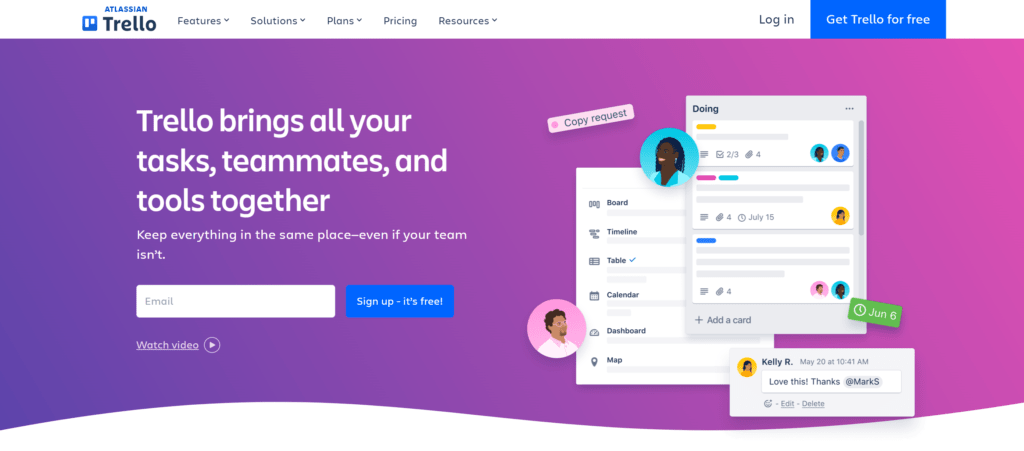
Trello is a powerful productivity tool that provides a simple, flexible, and organized way to manage tasks, teams, and tools. It can be used for a variety of purposes, such as project management, meetings, and task management. Trello offers integrations with other apps and Butler Automation for no-code automation, and Trello Enterprise is available for businesses needing more security and controls. It is trusted by millions of teams worldwide.
Trello utilizes boards, lists, and cards to organize tasks and ideas. Boards keep tasks organized and help teams move forward, while lists represent the different stages of a task. Cards contain all the information needed to complete the task, and different views such as Timeline and Calendar help teams stay on top of tasks and hit deadlines. Trello is priced for individuals, small teams, and organizations, and is designed to deliver value within 30 days.
Product Specs:
- Boards, lists, and cards used to organize tasks and ideas
- Integrations with other apps and Butler Automation for no-code automation
- Trello Enterprise available for organizations needing more security and controls
Pros:
- Simple, flexible, and powerful productivity tool
- Different views, such as Timeline and Calendar, help teams stay on top of tasks and hit deadlines
- Can be used for various purposes, including project management, meetings, task management, etc.
Cons:
- Limited customization and flexibility for complex projects
- Not as feature-rich compared to other project management tools
- Priced higher for organizations needing more security and controls.
4. Notion
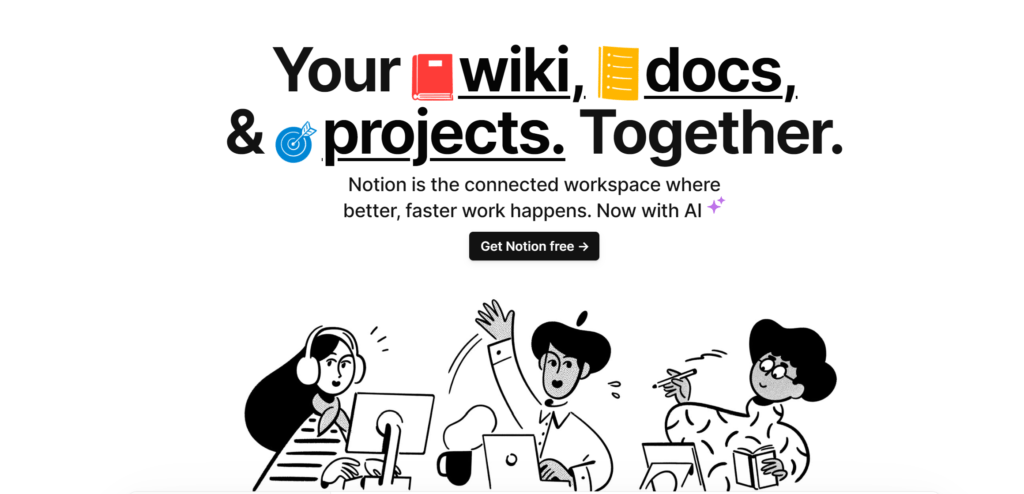
Notion is a comprehensive workspace that enables teams to collaborate on projects, centralize knowledge, and manage tasks more efficiently. Notion is a connected workspace that brings together the best of productivity and collaboration tools. With its AI capabilities, Notion allows users to create wikis, next-generation docs, and build powerful visualizations, filters, and sorting. It supports multiple languages and allows for customization of labels, tags, owners, and more. Notion has been praised by users for its ability to replace multiple tools and save on costs.
Product Specs:
- AI capabilities
- Create wikis and next-generation docs
- Powerful building blocks for visualization, filtering, and sorting
- Customization of labels, tags, owners, and more
- Drag and drop page building
Pros:
- Centralizes all your work in one place
- Allows teams to work side-by-side
- Supports multiple languages
- Offers a free trial
- Adaptable to your needs
Cons:
- Limited customer support
5. Asana

Asana, Inc. is a widely-used software in the domain of project and product management, renowned for its ability to help users plan and organize tasks efficiently. It is one of the market’s most popular project and product management tools, with its innovative design and features that enable users to create and manage projects, track progress, and collaborate with team members. Asana also offers features such as OKRs and SMART goals, which give users clear objectives and measurable milestones to work towards. Furthermore, Asana helps users to avoid scope creep by providing clear guidance on project objectives and deadlines.
Asana’s product specs include features such as task and project organization, collaboration tools, real-time notifications, and user-defined templates. It also provides a range of helpful resources such as guides and tutorials, which can help users to get the most out of the software and take advantage of its features.
Product Specs:
- Task and project organization
- Collaboration tools
- Real-time notifications
- User-defined templates
Pros:
- Intuitive design and user-friendly interface
- Range of features such as OKRs and SMART goals
- Comprehensive guides and tutorials
Cons:
- Lack of customization options
- Not suitable for more complex projects
- Subscription fee required to access all features
6. Wrike

Wrike is a comprehensive work management platform that offers a wide range of features, including general work management, project management, views, reporting, BI, work intelligence, workflow automation, resource management, advanced resource capacity planning, asset creation, collaboration, integration, and admin security.
It has a free plan, a team plan for $9.80 per user/month, a business plan for $24.80 per user/month, and various add-on capabilities with additional fees.
Wrike also offers customer support with its customer success team to help with any customer needs.
Product Specs:
- General work management
- Project management
- Views
- Reporting
- Advanced reporting
- BI
- Work intelligence
- Workflow automation
- Resource management
- Advanced resource capacity planning
- Asset creation
- Collaboration
- Integration
- Admin security
- Free plan
- Team plan for $9.80 per user/month
- Business plan for $24.80 per user/month
- Add-ons available for additional fee
Pros:
- Wide range of features
- Affordable plans
- Customer support with customer success team
Cons:
- Limited add-on capabilities
- Some features are only available in the higher priced plans
7. Basecamp
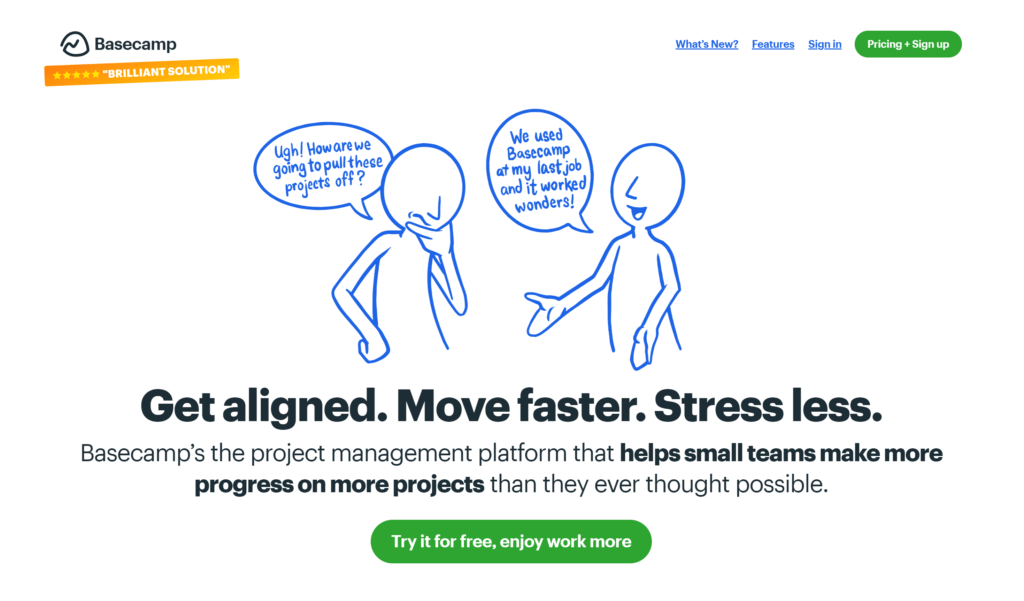
From Wrike’s all-in-one project management platform, we transition to Basecamp, a pressure-tested platform used by hundreds of thousands of teams on millions of projects.
Basecamp has a unified approach to project management that is easy to use and intuitive. It is the easiest place for everyone to work together on a project and is used by top-notch marketing firms, ad agencies, design shops, software developers, client services firms, IT firms, consultants, freelancers, builders, contractors, publishers, schools, governments, religious organizations, charities, non-profits, and first responders.
Basecamp improves users’ accountability, productivity, and transparency, reduces miscommunication and chaos, helps users better coordinate and align their teams, and provides peace of mind and a clear path to goals. This results in quicker turnaround times and more effective project management.
With over 1,000 customer testimonials and a features gallery showcasing everything the platform can do, Basecamp is the superior version of project management platform.
Product Specs:
- All-in-one project management platform
- Includes message board, to-dos, docs files, Campfire, schedule, and card table
- Unique set of tools and methods
- Features gallery showcasing everything the platform can do
Pros:
- Intentionally simple by design
- Easy to use and intuitive
- Improves accountability, productivity, and transparency
- Reduces miscommunication and chaos
- Helps users better coordinate and align their teams
- Provides peace of mind and a clear path to goals
Cons:
- May be difficult to learn the platform for novice users
- Some features are limited in comparison to other project management tools
- Not all features are available in the free version
8. Monday

Monday.com Work OS is a powerful platform that offers users streamlined workflows and increased collaboration. Built on a proven system trusted by over 180,000 customers worldwide, the platform centralizes all work, processes, tools, and files into one place. Its customizable workflows, automations, and notifications allow teams to collaborate more efficiently and get work done faster. Moreover, its tailored products for task and project management, sales, and product and development workflows enable teams to launch more product categories and expand into more markets in less time.
Product specs;
Multiple views such as Kanban board, calendar, timeline, and Gantt chart, as well as integrations with popular tools such as Slack, Dropbox, and Adobe Creative Cloud.
The platform also offers a variety of automation recipes and custom automations, customizable dashboards for tracking progress, timelines, and budgets, and building blocks such as boards, views, dashboards, integrations, automations, apps, and docs.
The pros;
- Ease of use due to its no-code platform
- 24/7 customer support with 2-hour average response time
- Award-winning platform with flexible product options
- Shortlisting in over 8 software categories
- Market leader across 18 categories
- Unlimited time on Free plan with no credit card needed
- Support superheroes available to help with platform use
The cons;
- Inability to track all team members’ progress in one view
- Some users feeling overwhelmed with the amount of customization options available.
9. Teamwork

Teamwork.com is a powerful platform designed to provide users with streamlined project management capabilities and increased collaboration. It offers a comprehensive suite of features, including the ability to manage projects, teams, and clients in one place; deliver work on time and on budget; plan, view, track time and budgets; scope work and see challenges before they arise; resource and workload management; set goals or checkpoints within a project; and gather requests, feedback, and key details from clients and team.
The platform is highly customizable, allowing users to add an unlimited number of free collaborators, set different privacy and permission levels, customize task lists, permissions, and categories, set up custom domains and logos, assign owners to individual projects, add followers to stay in the loop on progress, and automate steps in workflow and integrate with other tools. Teamwork.com also offers a free 30 day trial and is designed for project management, enabling users to log time directly, create timesheets, mark time as billable, create an invoice based on billable hours logged and expenses, and set rates for team members or projects.
Product Specs:
- Manage projects, team, and clients in one place
- Deliver work on time and on budget
- Plan, view, track time and budgets, collaborate, automate, and integrate
- Scope work and see challenges before they arise
- Resource and workload management
- Set goals or checkpoints within a project
- Gather requests, feedback, and key details from clients and team
- Give clients and contractors access for better collaboration and visibility
- Choose from various views (lists, kanban boards, tables, gantt charts, my work, everything)
- Log time directly, create timesheets, mark time as billable
- Create an invoice based on billable hours logged and expenses
- Set rates for team members or projects
- Create a custom budget for each project and track spend against it
- Manage long-term client work and fluctuating budgets
- Track extra expenses against the project budget
- Track tasks, subtasks, custom fields, tags, files, and versions
- Manage the entire client review and approval process
- Get visibility into performance and stay on track with various reports
- Automate steps in workflow and integrate with other tools
- Manage client communications, chat, organize content, and CRM in one place
Pros:
- Unlimited free collaborators can be added to the subscription
- Different privacy and permission levels can be set for users
- Teamwork.com is customizable with filters and defaults
- Custom domain and logos can be set up for the team or by project
- Work can be assigned to teams and sub-teams
- Owners can be assigned to individual projects for accountability
- Followers can be added to stay in the loop on progress
- Teamwork.com offers a free 30 day trial
- Collaborators can complete tasks and milestones assigned to them
- Users can view project information through different customized lenses
- Filters can be saved for future use
Cons:
- Collaborators have reduced permissions compared to standard users
- Advanced privacy levels and permissions can be specified
10. ClickUp
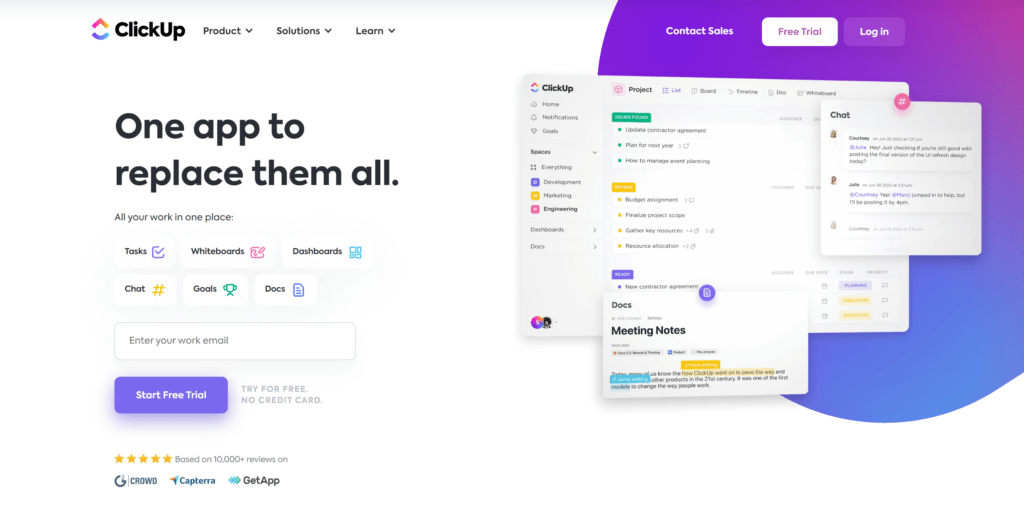
The transition from Teamwork to ClickUp is easy, as both are project management software options available for mid-sized teams. ClickUp is a highly recommended project management tool for its ease, flexibility, and simplicity. It offers many features that other project management software can’t match, and can transform the way teams work forever. It has received positive reviews from users for its improved efficiency, and its UI is better than Monday.com.
Features:
- Automations
- Map view
- Wiki feature
It also offers a 100% satisfaction guarantee, refunds within 30 days, and discounts for nonprofits, students, educators, and startups. ClickUp’s Free Forever Plan offers an unmatched level of functionality, and tasks do not count against storage, only file attachments. Payments are per Workspace, and each Workspace requires an individual upgrade. ClickUp also offers users demos to demonstrate paid plan features, and provides a grace period to find the plan that works best.
It is serious about security and privacy, offers the highest levels of uptime in the last 12 months, and has a knowledgeable sales team ready to help users. Resources are available to apply for startup credits, nonprofits to claim their discount, and students, educators, and administrators to claim their academic discount. ClickUp also uses cookies on the site, and users can change their settings at any time.
11. Process.st
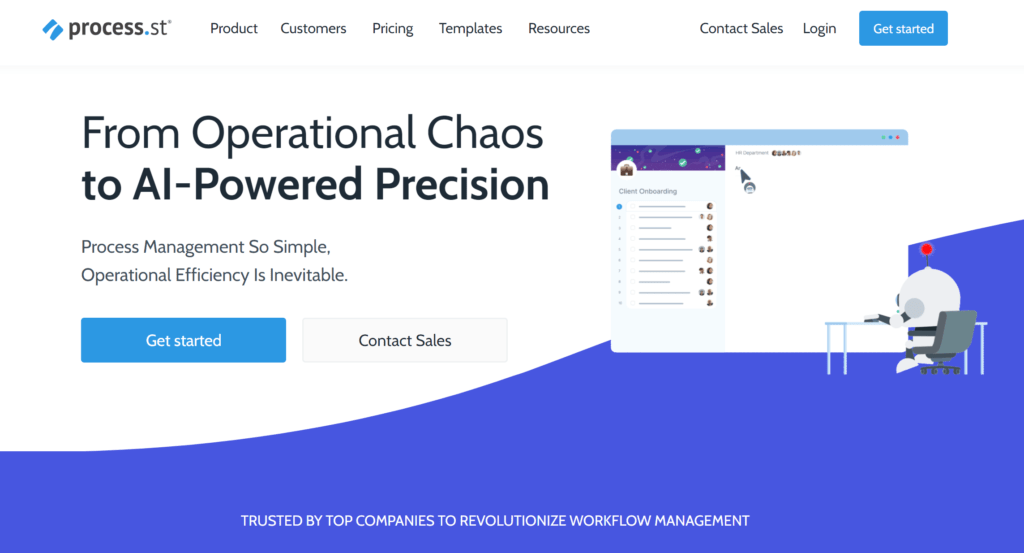
Process.st is a comprehensive checklist, workflow, and SOP software that provides users with AI-powered process management and task assignment capabilities. It offers a wide range of features such as task assignments, approvals, conditional logic, integrations, scheduler, groups, ChatGPT-powered AI-powered workflow design, forms feature for creating and customizing forms, surveys, and quizzes, data sets for storing and accessing data, and pages for capturing and sharing standard operating procedures (SOPs).
Process.st serves a variety of industries such as:
- HR teams for onboarding process
- Property management for workflow automation
- Marketing teams for process streamlining
- Customer success teams for workflow optimization
- Sales teams for revenue-generating activities
- Operations managers for process automation
Product Specs:
- Task assignments
- Approvals
- Conditional logic
- Integrations
- Scheduler
- Groups
- ChatGPT powered AI-powered workflow design
- Forms feature for creating and customizing forms, surveys, and quizzes
- Data Sets for storing and accessing data
- Pages for capturing and sharing standard operating procedures (SOPs)
Cons:
- Not all features are available in the free version
- Learning curve for some of the more complex features
12. Project Planner
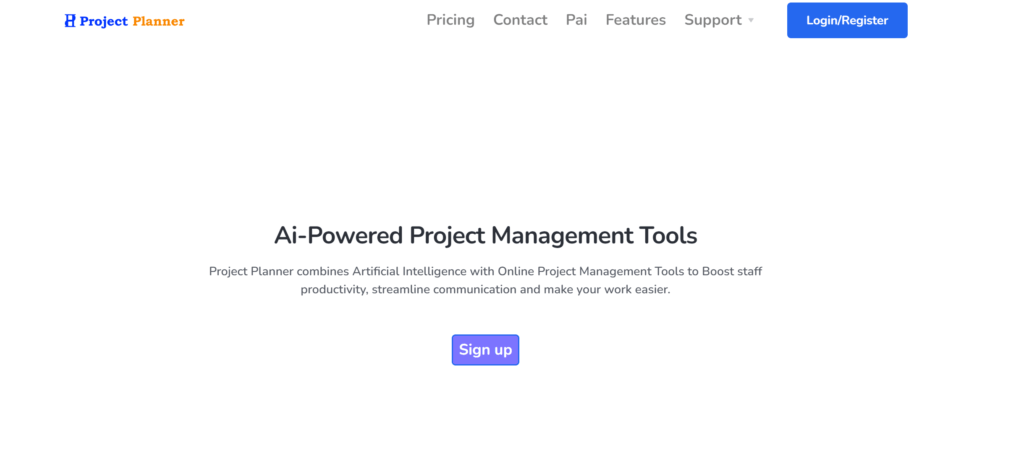
Project Planner is a powerful AI-powered project management tool that is increasingly gaining popularity in the business world. It allows users to streamline communication, automate work reporting, and make real-time decisions. It also has a 7-step process that facilitates the use of the tool and provides users with financial and performance reports. The tool also features instant alerts for tasks assigned to team members, allowing teams to meet deadlines and deliver quality work. Furthermore, Project Planner is customizable and provides additional project management tools to suit different businesses.
The pricing for Project Planner is highly competitive at $6/month or $60/year per user. Trusted in 4 continents, Project Planner has also received positive customer feedback. With a sign up option and book a demo or try now option, users can quickly get started with using the tool. Icons of a laptop and a chat are used to visually appeal to potential customers. The help center and blog provide users with support and information.
Product Specs:
- AI-powered project management tools
- Boosts staff productivity
- Streamlines communication
- Pai AI assistant
- Instant alerts for assigned tasks
- Automates work reporting
- Real-time decision making
- 7-step process for using Project Planner
- Financial and performance reports available
- Instant communication with team members
- Additional project management tools available
- Fully customizable features
Pros:
- Helps team meet deadlines
- Delivers quality work
- Ideal for different businesses
- Highly competitive pricing
- Positive feedback from customers
- Easy to get started
- Visual appeal
- Support and information available
Cons:
- Not suitable for all businesses
- Initial setup may be time-consuming
- Additional fees for additional features
- Potential compatibility issues between different systems
- Learning curve for new users
- Lack of customer service in some regions
13. Project Insight
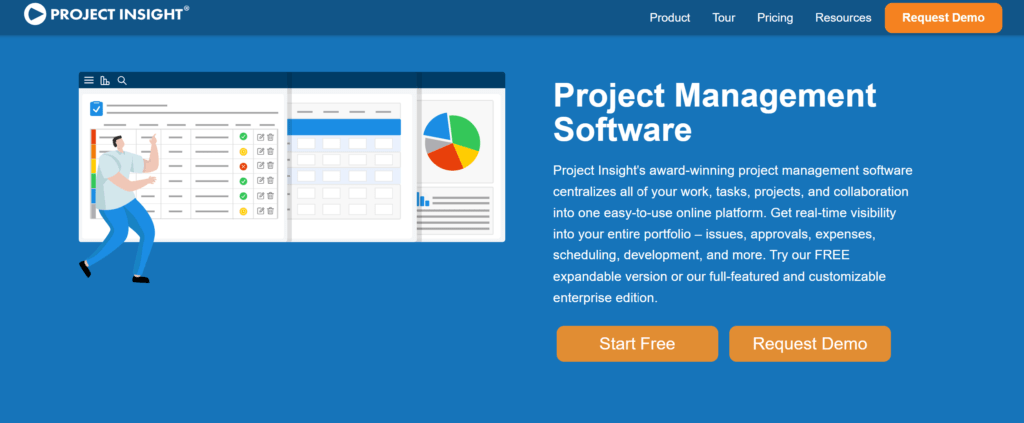
Award-winning Project Insights provides a comprehensive platform to streamline projects, automate processes, and increase visibility into entire portfolios. It offers a free expandable version as well as a customizable enterprise edition to best suit businesses’ needs. With over two decades of experience in helping thousands of companies manage their work, the company is a trusted advisor for all things work management.
Features:
- Real-time visibility into an entire portfolio, including issues, approvals, expenses, scheduling, and development
- Automated budgeting, resource allocation, proposals, time-tracking, appointments, sprints, and more
- A webinar series called Insightable Insights to help companies get the most out of the software.
Product Specs:
- Centralizes work, tasks, projects, and collaboration into one platform
- Fully-customizable to suit business needs
Pros:
- Comprehensive platform to streamline projects, automate processes, and increase visibility
- Free expandable version
- Customizable enterprise edition available
- Over two decades of experience
- Insightable Insights Webinar Series
Cons:
- May require a learning curve for some users
- Can be expensive to upgrade to enterprise edition
14. Kintone

Kintone is a comprehensive workplace platform that provides powerful capabilities for managing team data, tasks, and communication. It is trusted by 25,000+ companies worldwide and is used to centralize and organize work in one place.
Kintone tracks and shares tasks and data for collaboration, unifies data and conversations for easy reference, simplifies and customizes workflows with automation, and gives teams access to data anytime, anywhere. It also converts spreadsheets into dynamic databases, provides a holistic view of team projects and processes, eliminates conversation silos and redundancies, and organizes conversations by topic or project.
Kintone also designs workflows that fit the team’s needs, automates tedious workflow tasks, works on any device, ensures data security, keeps teams connected with a digital workspace and international language support, provides granular permissions controls, allows for uploading and converting spreadsheets into database apps with no coding required, and offers a free trial or demo.
Product Specs:
- Customizable workplace platform for managing team data, tasks, and communication
- Trusted by 25,000+ companies worldwide
- Centralizes and organizes work in one place
- Tracks and shares tasks and data for collaboration
- Unifies data and conversations for easy reference
- Simplifies and customizes workflows with automation
- Gives team access to data anytime, anywhere
- Converts spreadsheets into dynamic databases
- Provides a holistic view of team projects and processes
- Communicates directly with team in the database
- Eliminates conversation silos and redundancies
- Organizes conversations by topic or project
- Designs workflows that fit the team’s needs
- Automates tedious workflow tasks
- Works on any device
- Ensures data security
- Keeps team connected with digital workspace and international language support
- Allows for granular permissions controls
- Provides revision history for accountability
- Offers dedicated threads within each workspace
- Provides a library of extensions for integration and visualization of data
- Allows for uploading and converting spreadsheets into database apps with no coding required
- Offers a free trial or demo
- Has a product introduction video available
Pros:
- Easy to use and customize
- Secure and reliable
- Comprehensive suite of features
- Automates tedious workflow tasks
- Works across multiple devices
- Provides granular permissions controls
- Allows for uploading and converting spreadsheets into database apps with no coding required
- Offers a free trial or demo
Cons:
- No real-time collaboration capabilities
- No dedicated customer support service
- No integration with other third-party applications
- Limited storage capacity for large datasets
15. Forecast
Forecast is a comprehensive AI-driven solution for streamlining work, resources, and financials. It is a Professional Services Automation software for software teams, connecting all work and data and augmenting existing tools to optimize workflows for internal teams. Forecast provides visibility into sales, services, and finance, helping teams better utilize resources, plan projects, and manage tasks. Artificial intelligence is used for intelligent recommendations and proactive measures, allowing users to spot inefficiencies before scope and budget go overboard.
The platform is also available for requesting a demo and exploring its features, such as Forecast software which enables estimation and evaluation of team allocation.
Product Specs:
- AI-driven solution for streamlining work, resources, and financials
- All work and data are connected
- Project management, resource management, and financial management
- Uses artificial intelligence for intelligent recommendations and proactive measures
- Professional Services Automation software for software teams
- Augments existing tools and optimizes workflows for internal teams
- Provides visibility into sales, services, and finance
- Helps better utilize teams, plan projects, and manage tasks
- Helps spot inefficiencies before scope and budget go overboard
Pros:
- Ensures efficient delivery from planning to completion
- Helps better utilize teams, plan projects, and manage tasks
- Offers a platform for requesting a demo and exploring features
- Forecast software enables estimation and evaluation of team allocation
Cons:
- Limited customization options
- Lack of training resources
2023 Project Management Trends
As businesses look for ways to become more efficient and effective, project management trends continue to evolve to meet the needs of modern organizations. AI-powered project management tools are becoming increasingly prevalent and are gaining in popularity as they provide a range of advantages over traditional project management approaches.
Here are three of the most noteworthy project management trends for 2023:
- AI-driven project management: AI-driven project management tools are becoming increasingly popular as they provide a range of advantages over traditional project management approaches. These tools leverage AI to automate mundane tasks, streamline processes and improve collaboration between team members. This allows teams to focus on higher-level tasks, such as strategy and creative problem-solving.
- Remote collaboration: Remote collaboration is becoming the new normal in the workplace. Projects are increasingly being managed with virtual teams working across different locations. Project management software can help facilitate remote collaboration by providing a single platform for stakeholders to communicate and track progress.
- Agile project management: Agile project management is becoming more popular as it is an iterative process that focuses on delivering projects in short sprints. This approach allows teams to rapidly respond to changes, embrace customer feedback and quickly adapt to shifting project requirements. Additionally, Agile project management tools provide complete visibility into the project, enabling teams to track and measure progress.
FAQ
Why is project management critical?
Properly managing a project is essential in order to achieve successful outcomes and ultimately realize a project’s objectives. Project management enables teams to plan projects efficiently, allocate resources effectively, manage risks and establish communication among involved parties. It also serves as a platform for decision-making that can help to identify potential problems and solutions.
Project management is important because it:
- Helps maintain productivity and team accountability
- Enhances organizational structure and communication
- Ensures that projects are completed on time and within budget
It is also important to note that proper project management requires well-defined processes and procedures that are tailored to the specific project. Additionally, effective project management requires the team to have the necessary skills, knowledge, and resources to complete the project and meet the desired goals.
What is the best project management software for small businesses?
Small businesses can benefit greatly from project management software that is tailored to their needs and budget. Out of the many software options available, ClickUp, monday.com, Asana, Zoho Projects, Smartsheet, Notion, Airtable, Teamwork, Wrike, and Jira stand out as the best project management software for small businesses in 2023.
All of these have different pricing options, feature sets, customer support, and ease of use. For example, ClickUp offers Agile Scrum features, monday.com offers a free version for small teams, and Asana has multiple project views, built-in cross-team collaboration, and hundreds of integrations. Additionally, all of these tools offer budget planning, resource management, task management, risk management, reporting and charting, mobile apps, collaboration tools, client management, and integration capabilities.
To choose the best project management software for small businesses, it is important to assess the cost and added fees, overall features and functionality, reporting, integration capabilities, necessary features vs. feature overload, customer reviews, and customer support. This will ensure the software is tailored to the needs of the small business and provides a valuable return on investment.
What are the three main types of project management software?
Differentiating between the three main types of project management software can help businesses make an informed decision when selecting the right software for their needs.
The three main categories of project management software are construction project management, project portfolio management, and Gantt chart software.
Construction project management software focuses on the planning, scheduling, and tracking of construction projects such as buildings and infrastructure. This type of software helps construction project managers ensure that projects are completed according to budget, safety, and quality requirements.
Project portfolio management software is used to manage multiple projects across departments or teams and is often used to monitor the performance of portfolios of projects. This software helps prioritize objectives, manage resources, and track progress.
Gantt chart software is used to create timelines and track progress and performance. This type of software helps to organize tasks into a timeline, assign tasks to team members, and track progress and deadlines. It also helps to identify potential delays and risks, and allows for efficient resource management.
Each of these three types of project management software offer unique features and benefits, and businesses should select a software that best meets their individual needs.
What are the benefits of project management software?
The use of project management software provides a range of benefits for any organization seeking to manage their projects efficiently. By using project management software, projects can be planned more easily, tasks can be allocated more effectively, teams can be organized more clearly, and deadlines and goals can be met more promptly.
In addition, some project management software provide additional features that help in project budgeting, resource utilization, task management, and risk management. These features can be highly beneficial for organizations of any size in helping to ensure their project’s success.
For example, budget planning tools allow users to upload their set budget and then track expenses and invoices to compare project costs to the planned budget. This helps to ensure that projects do not run over budget or stop due to lack of funds. Resource utilization tools allow users to plan, track, and record where resources are used in the project’s execution. Task management features can automate redundant tasks, such as invoicing, and manage project workflows.
Risk management features help to balance competing demands and ensure that projects are finished as intended. Reports and charts provide an overview of a project’s timeline, budget, and quality. Mobile apps enable teams to track, manage, and deliver project deliverables from anywhere. Integrations with other software can be used to maximize the project management software’s performance.
Client management tools allow clients to be included in the project’s execution and receive updates on the project’s status. Finally, collaboration tools enable team members to work together seamlessly, even across locations.
Project management software provides organizations with a range of benefits that help ensure project success. These features can be utilized to maximize the project management software’s performance and help ensure that project deadlines and goals are met.
What are the different types of project management methods that are popular now?
Modern project management techniques have become increasingly popular in today’s business environment. Several different types of project management methods are commonly used, each with their own benefits and drawbacks.
These include:
- Agile: Agile is a flexible and adaptive project management methodology that is based on collaboration and iteration. It focuses on delivering value to the customer quickly and continuously.
- Waterfall: Waterfall is a sequential project management methodology that focuses on planning and then executing each phase of the project one at a time.
- Lean: Lean is a project management methodology that focuses on eliminating waste, increasing efficiency, and delivering value to customers in a timely and cost-effective manner.
- Scrum: Scrum is an iterative and incremental project management methodology that is based on the agile principles of collaboration and iteration. It focuses on delivering value to the customer quickly and continuously.
- Iterative: Iterative is a project management methodology that focuses on breaking down complex tasks into smaller tasks and then iterating on those tasks until the project is completed.
- Kanban: Kanban is a project management methodology that focuses on visualizing workflows and tasks and making sure that tasks are completed on time. It is based on the principles of continuous improvement and incremental delivery.
Is project management software secure?
Transitioning from the previous subtopic, which discussed various project management methods, this article will now explore the security of project management software. In the age of digital transformation, project management software is increasingly being adopted by organizations as a way to streamline project processes. As such, the security of these tools is of paramount importance.
Project management software providers generally employ a range of security measures to protect their users’ data. These measures can include encryption of stored data, authentication protocols to verify the identity of users, and two-factor authentication. Additionally, many providers comply with industry standards such as data privacy regulations like the EU’s General Data Protection Regulation (GDPR). These measures help keep a user’s data secure and private.
However, it is important to note that no system is perfect, and users should still take steps to ensure that their data remains secure. For example, users should make sure to use strong passwords and update them regularly, and should be aware of and avoid potential phishing scams.
Who are project managers, and what do they do?
Project managers are key professionals who are responsible for the effective and efficient execution of a project. They are responsible for planning, organizing and leading a team’s work to achieve a project’s objectives. Project managers are also responsible for communicating with stakeholders, ensuring that resources are used efficiently, measuring project performance and managing risk.
Project managers have a variety of duties and responsibilities:
- Developing project plans, tracking progress, and assessing the impact of changes
- Establishing budgets and timelines for the project
- Ensuring that the project meets its objectives and is completed on time
- Negotiating with stakeholders and team members to ensure the success of the project
Project managers play a vital role in the success of any project and must possess a variety of skills, including strong communication and problem-solving skills, the ability to manage multiple tasks and teams effectively, and the ability to make decisions quickly and efficiently. They must also understand the project’s scope and objectives, as well as the tools and techniques needed to achieve them.
Conclusion
Project management software has come a long way in the past few years, and in 2023, the most successful teams will be those who leverage the power of AI.
When selecting the right software for your team, it is important to consider pricing, features, customer support, ease of use, and other category-specific attributes.
With a clear understanding of your project goals and the right AI-powered software, you can ensure success in 2023.

